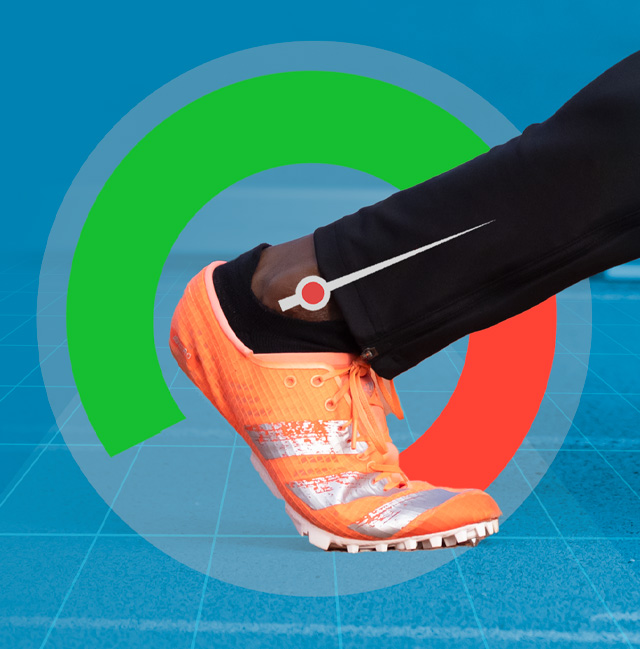The equation for world-class speed is brutally simple. You have to do two things:
Strike the ground with 4-4.5 times your bodyweight in force.
Do it in less than a tenth of a second - faster than you can blink.
There's just one problem: the math doesn't add up.
The absolute speed limit for a muscle to reach peak force is 300 milliseconds. That's three times too slow.
This isn't a training issue. It's not genetics. It's biology.
Your muscle fibers (even Usain Bolt’s) are physically incapable of reaching their peak force in the tiny window of time the foot is on the ground.
So how do elite sprinters break this ‘speed limit?'They tap into the fastest system for propulsion the human body has: the optimized partnership between muscle and tendon.
To understand how you can apply this principle, you first need to know how the system functions.
Before your foot ever hits the ground, your calf muscle pre-activates, not to push, but to become a rigid frame. This allows your Achilles tendon to stretch and store massive elastic energy, like pulling back a slingshot.
At impact, that stored energy is unleashed. Your muscle just holds tight while the tendon does the launching.
The numbers are staggering:
at top speed, 53-75% of ankle propulsion comes from tendon recoil, not muscle contraction. Your calves aren't pushing you forward, they're just the frame holding the spring.
This is why so many athletes hit a frustrating plateau: getting stronger in the weight room doesn't always translate to faster times on the track.
It’s the reason a "weight room monster" can get torched by a leaner, more elastic athlete.
While one is trying to muscle their way through the ground, the other is bouncing, using a spring system that can return energy far faster than any muscle can generate it.
The fix: Train your tendons with the specific, high-tension exercises that actually trigger adaptation. We've built a complete, free 12-week protocol based on the latest research to show you exactly how.
Get the full, science-backed guide here."Run on your toes" is a cue that just won't die.
We get questions about it constantly, and despite all the evidence, coaches and athletes still throw this advice around like it's gospel.
Yes, elite sprinters make contact on the ball of the foot.
But here's what happens when athletes hear "run on your toes": they almost always actively point their foot down (plantarflex) before ground contact, thinking they're being fast.
They just turned off their most powerful speed weapon.
Remember that biological spring we just talked about? The one that delivers up to 75% of your propulsion?
When you point your toes down, you create a soft, floppy ankle.
The force being applied to the track hits that marshmallow joint and your heel collapses backward, killing the stretch reflex that makes tendon recoil possible.
Watch elite sprinters in slow-motion and you'll see the opposite: they approach the ground with toes pulled UP toward the shin (dorsiflexed).
This pre-tensions the Achilles like drawing a bow. The ankle becomes rigid steel, not a wet noodle.
Every millisecond of heel collapse is wasted time. In a sport measured in hundredths, those lost milliseconds compound into the difference between winning and wondering what went wrong.
The fix: Prioritize dorsiflexion in everything you do, from warm-up A-skips to acceleration work. Proper ground contact isn't optional for fast sprinting. Think "toes up on approach, let the spring work." The ball of foot contact happens naturally when you set up the ankle correctly.
What if the biggest breakthrough in tendon training came from the main ingredient in Jell-O?
UC Davis researcher Keith Baar discovered a protocol that sounds too simple to be true: consuming gelatin before training literally
doubles the rate of collagen synthesis.Not 20% better. Not 50% better. Double.
The science is elegant. Tendons have terrible blood supply, but every time you load them, fluid gets squeezed out.
When the load releases, they suck that fluid back in like a sponge.
Time it right (nutrients peaking exactly when mechanical loading occurs) and you flood that sponge with the raw materials it needs to rebuild.
The Protocol:-15g unflavored gelatin
-50mg Vitamin C
-Consume exactly 60 minutes before training
While athletes spend thousands on questionable injections, a simple, science-backed advantage that can double the collagen markers in subjects' blood sits right on the grocery store shelf.
The Takeaway: Stop leaving gains on the table. Set a timer 60 minutes before your next session and give your tendons the fuel they need to rebuild stronger. The hard part isn't the protocol, it's believing something this simple actually works.
